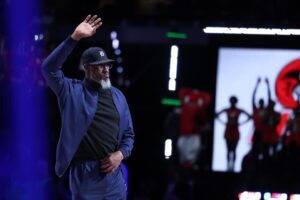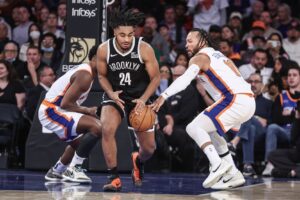While well-meaning, the G League Ignite’s decision to put several top NBA Draft prospects and NBA veterans on a single team has turned into an unscrupulous endeavor.
Honestly, it should have been expected. In competitive environments, egos and personal agendas clash. There are 14 lottery picks in every draft. However, most highly-touted prospects want to be the No. 1 pick and play like it. Even powerhouse Kentucky only has three or four lottery-caliber prospects at one time. The Ignite often has at least twice that many.
There have been success stories, like those of Jalen Green, Jonathan Kuminga, Dyson Daniel, and Scoot Henderson. Each player signed with the Ignite to get a jump start on what it takes to play professional basketball and to become a lottery pick. Green and Kuminga are currently in the midst of breakout seasons. All four players are top-10 NBA Draft selections.
Nonetheless, they aren’t surprised by NBA commissioner Adam Silver shutting the Ignite down.
Scoot Henderson Opens Up About G League Ignite Shutdown
“Honestly, I wasn’t [surprised],” Henderson tells Sean Highkin of The Rose Garden Report. “… It did surprise me a little with how quick it happened. But it’s better that it happens now than a couple years from now.”
In 2021, Henderson signed a two-year contract with the Ignite as a five-star high school prospect out of Georgia. In making that decision, the 17-year-old became the youngest professional basketball player in U.S. history and the first prospect to spend two seasons in the Ignite program.
A Thankful Student
Henderson’s sustained relationship with former head coach Jason Hart is a testament to the close-knit bonds the program develops behind the scenes. He also maintains a friendship with several former teammates. One such person is Pooh Jeter, a former college standout who played 62 career games in the NBA. The 40-year-old is now a player development coach for the Blazers and mentors Henderson.
Again, Henderson understands why the Ignite met their demise. He’s just grateful for his time with the team. Having gone through the fire with Ignite, he has a perspective that only a few can share. He saw firsthand how much went into developing kids straight out of high school.
“There were multiple reasons that it shut down,” Henderson says. “But whoever played on the team and made an impact for ourselves and in the world, that’s all you can think about.”
“I really thank the people at Ignite,” Henderson continues. “The little people that you don’t see.”
“They don’t really get enough credit for how much they have to pour into us. The coaches, they don’t get enough credit for having to get guys from high school, to get them up to speed in a few weeks to play some grown men that have children to feed. You don’t see that. You see them getting beat a lot and having a horrible record. You don’t see the things that they go through day-to-day.
“From my viewpoint,” Henderson concludes, “they helped me in a huge way to be where I am right now. I can’t thank them enough.”
Prioritizing Player Development
While the on-court product is often questioned, Silver’s motivation to end the Ignite program was partly practical and partly financial. The NCAA allowing Name, Image, and Likeness (NIL) deals has taken away the Ignite’s exclusive status as an American program that can pay a sizable dollar sum to top prospects. With fewer of those prospects likely to take the Ignite route as a result, the NBA would have been siphoning money into a marginalized product.
However, Silver is still focused on the player development of American prospects in particular.






